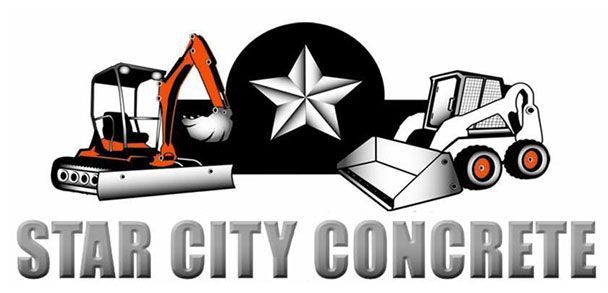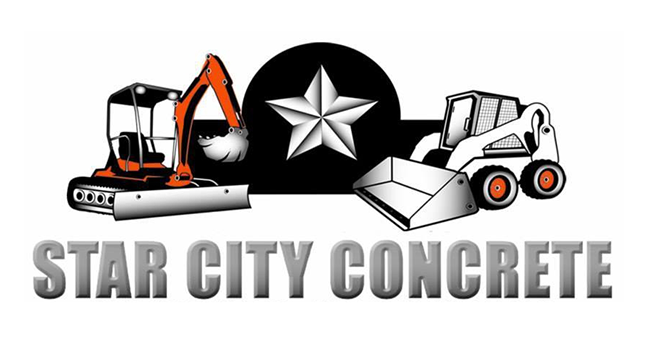Concrete Care and Tips
Star City Concrete LLC
Resources for Maintaining Your Concrete
Star City Concrete LLC wants your concrete installation to last for years. We've assembled this page to provide valuable information and help you keep your concrete in excellent condition. Divided into five sections, you'll find essential tips on curing, proper use, long-term care and de-icing, control joints, and stain removal. For more detailed information, or a free estimate on your concrete needs, contact Star City today.
Curing
After your concrete has been completely installed, we have some recommendations for you: We need to begin to water cure your concrete. This is for stronger and longer lasting concrete. We need your participation in this by simply applying water to the surface until saturated. Do this 3 times a day when temperatures are above 70 degrees and 5 times a day when temperatures are above 85 degrees. (Note: If it is under 70 degrees, this does not need to be done). These intervals should be spaced out in even increments if possible. The first watering should be between 7 and 8 a.m. the following morning after being poured, unless your concrete is going to be sawcut, THEN YOU WILL NEED TO WAIT UNTIL AFTER IT HAS BEEN SAWCUT TO BEGIN TO WATER. The purpose of this process is to keep the curing concrete as cool as possible during the first 3 days. The first day is most important and the need decreases by the third day. There are many studies that support this. Water curing is the most environmentally safe and the best way to cure new concrete. Again, watering only needs to be done if temperatures are above 70 degrees. It is very important that after your seed/grass is replaced it stays moist, as drying out will cause it to die. This should be done for a week or two until it has a chance to bond again.
Please also note that newly-poured concrete goes through changes during the curing process, and the next day is usually the period when it is most unattractive. The color will lighten up and become more uniform within a few weeks.
Waiting Before Use
You can walk on your concrete 24 hours after the concrete is poured, cars and light pickup trucks 7 days after concrete is poured, and heavy equipment and campers 28 days after pour. For patios, you can place patio furniture on the new concrete after 3 days, and a hot tub after 1 week.
Note: Trash trucks, Roofing trucks, Mulch trucks & Moving trucks are known to crack otherwise good concrete. This is due to the gross vehicle weight. A standard driveway is not designed to withstand that weight even once.
Long-Term Care and De-Icing
Salt and many de-icing materials will harm the concrete finish, especially in its first season. Before de-icing, read all warnings on your product's packaging. We recommend Calcium Flake Ice Melt, or, to create traction in snow and ice, the best solution is sand.
Control Joints
Shrinkage cracks should form in control joints. If you notice a crack outside of these joints, they will need time to open up. At that time, the crack can be filled. Cracks form during the curing process as stress relief and are a natural part of concrete installation. If a crack has a different level on one side from heaving or settling, then call our office for an appointment so we may investigate and offer a resolution.
Stains
Concrete is porous and is easily stained by biomaterial, mulch, oils, and rust (most organic stains such as leaf imprints, etc., will degrade and disappear). Even when cleaning vehicles, the runoff can cause stains to occur. Over time, concrete gets dirty. If you use a pressure washer, use a low-pressure tip, and no more than 3000 psi usually does a good job. We recommend pre-treating with a 1:1 bleach and Dawn solution rubbed in with a deck brush. Berries, walnuts, leaves and bird droppings are all biomaterial that turns acidic and harms the surface. By bleaching, you neutralize the acid as well as whiten the concrete. We recommend this be done in spring to get any of the winter salt washed off as well.
ROCK POPS
Rock pops, unfortunately, are unavoidable due to the material the concrete is composed of, the cold to hot temperature changes in our region, as well as the chemicals used during the winter on roadways that is brought onto your concrete from driving on them. They do not, however, harm the integrity of the concrete. Applying a penetrating sealer 30 days after the concrete has cured can help minimize these issues. You can do it yourself by getting a penetrating sealer from stores such as Contractor Supply of Dayton, Janell Concrete & Masonry Equipment, or White Cap, or we would be happy to give you an estimate to apply this for you.
Star City Concrete thanks you for choosing us to install your concrete project. We are happy to answer any questions and provide service long after your warranty is up. Keep us in mind the next time a friend or family member mentions needing a concrete project done right.


Share On: